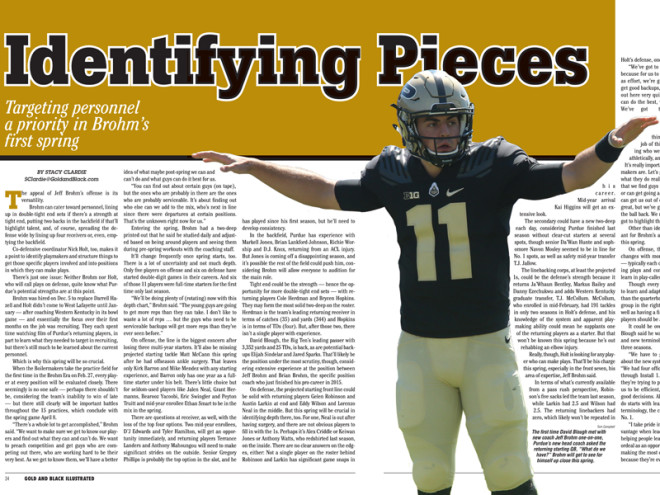This story initially published in Gold and Black Illustrated's recruiting issue. Order a copy here.

Spring preview series ($): Offense | Defense | Special teams | Projected depth chart
The appeal of Jeff Brohm’s offense is its versatility.
Brohm can cater toward personnel, lining up in double-tight end sets if there’s a strength at tight end, putting two backs in the backfield if that’ll highlight talent, and, of course, spreading the defense wide by lining up four receivers or, even, emptying the backfield.
Co-defensive coordinator Nick Holt, too, makes it a point to identify playmakers and structure things to get those specific players involved and into positions in which they can make plays.
There’s just one issue: Neither Brohm nor Holt, who will call plays on defense, quite knows what Purdue’s potential strengths are at this point.
Brohm was hired on Dec. 5 to replace Darrell Hazell and Holt didn’t come to West Lafayette until January — after coaching Western Kentucky in its bowl game — and essentially the focus over their first months on the job was recruiting. They each spent time watching film of Purdue’s returning players, in part to learn what they needed to target in recruiting, but there’s still much to be learned about the current personnel.
Which is why this spring will be so crucial.
When the Boilermakers take the practice field for the first time in the Brohm Era on Feb. 27, every player at every position will be evaluated closely. There seemingly is no one safe — perhaps there shouldn’t be, considering the team’s inability to win of late — but there still clearly will be important battles throughout the 15 practices, which conclude with the spring game April 8.
“There’s a whole lot to get accomplished,” Brohm said. “We want to make sure we get to know our players and find out what they can and can’t do. We want to preach competition and get guys who are competing out there, who are working hard to be their very best. As we get to know them, we’ll have a better idea of what maybe post-spring we can and can’t do and what guys can do it best for us.
“You can find out about certain guys (on tape), but the ones who are probably in there are the ones who are probably serviceable. It’s about finding out who else can we add to the mix, who’s next in line since there were quite a bit of departures at certain positions. That’s the unknown right now for us.”
Entering the spring, Brohm had a two-deep printed out that he said he studied daily and adjusted based on being around players and seeing them during pre-spring workouts with the coaching staff.
It’ll change frequently once spring starts, too. There is a lot of uncertainty and not much depth. Only five players on offense and six on defense have started double-digit games in their careers. And six of those 11 players were full-time starters for the first time only last season.
“We’ll be doing plenty of (rotating) now with this depth chart,” Brohm said. “The young guys are going to get more reps than they can take. I don’t like to waste a lot of reps … but the guys who need to be serviceable backups will get more reps than they’ve ever seen before.”
On offense, the line is the biggest concern after losing three multi-year starters. It’ll also be missing projected starting tackle Matt McCann this spring after he had offseason ankle surgery. That leaves only Kirk Barron and Mike Mendez with any starting experience, and Barron only has one year as a full-time starter under his belt. There’s little choice but for seldom-used players like Jalen Neal, Grant Hermanns, Bearooz Yacoobi, Eric Swingler and Peyton Truitt and mid-year enrollee Ethan Smart to be in the mix in the spring.
There are questions at receiver, as well, with the loss of the top four options. Two mid-year enrollees, D’J Edwards and Tyler Hamilton, will get an opportunity immediately, and returning players Terrance Landers and Anthony Mahoungou will need to make significant strides on the outside. Senior Gregory Phillips is probably the top option in the slot, and he has played since his first season, but he’ll need to develop consistency.
In the backfield, Purdue seems loaded with Markell Jones, Brian Lankford-Johnson, Richie Worship and D.J. Knox, returning from an ACL injury. But Jones is coming off a disappointing season, and it’s possible the rest of the field could push him, considering Brohm will allow everyone to audition for the main role.
Tight end could be the strength — hence the opportunity for more double-tight end sets — with returning players Cole Herdman and Brycen Hopkins. They may form the most solid two-deep on the roster. Herdman is the team’s leading returning receiver in terms of catches (35) and yards (344) and Hopkins is in terms of TDs (four). But, after those two, there isn’t a single player with experience.
David Blough, the Big Ten’s leading passer with 3,352 yards and 25 TDs, is back, as are potential backups Elijah Sindelar and Jared Sparks. That’ll likely be the position under the most scrutiny, though, considering extensive experience at the position between Jeff Brohm and Brian Brohm, the specific position coach who just finished his pro career in 2015.
On defense, the projected starting front line could be solid with returning players Gelen Robinson and Austin Larkin at end and Eddy Wilson and Lorenzo Neal in the middle. But this spring will be crucial in identifying depth there, too. For one, Neal is out after having surgery, and there are not obvious players to fill in with the 1s. Perhaps it’s Alex Criddle or Keiwan Jones or Anthony Watts, who redshirted last season, on the inside. There are no clear answers on the edges, either: Not a single player on the roster behind Robinson and Larkin has played significant game snaps in his career. Mid-year arrival Kai Higgins will get an extensive look.
The secondary could have a new two-deep each day, considering Purdue finished last season without clear-cut starters at several spots, though senior Da’Wan Hunte and sophomore Navon Mosley seemed to be in line for No. 1 spots, as well as safety mid-year transfer T.J. Jallow.
The linebacking corps, at least the projected 1s, could be the defense’s strength because it returns middle linebacker Ja’Whaun Bentley and outside ’backers Markus Bailey and Danny Ezechukwu and adds Western Kentucky graduate transfer T.J. McCollum. McCollum, who enrolled in mid-February, had 191 tackles in only two seasons in Holt’s defense, and his knowledge of the system and apparent playmaking ability could mean he supplants one of the returning players as a starter. But that wouldn’t be until the fall — he’s out this spring while rehabbing elbow surgery.
Really, though, Holt is looking for any player who can make plays. That’ll be his charge this spring, especially in the front seven, his area of expertise, Jeff Brohm said.
In terms of what’s currently available from a pass rush perspective, Robinson’s five sacks led the team last season, while Larkin had 2.5 and Wilson had 2.5. The returning linebackers had zero, which likely won’t be repeated in Holt’s defense, one that calls on the ’backers to blitz.
“We’ve got to find 22 really, really good players because for us to play at the level we want to as far as effort, we’re going to get tired, so we’ve got to get good backups,” Holt said. “But we’ve got to find out here very quickly in spring ball what our guys can do the best, who they are as football players. We’ve got to make sure we have the kids in the right positions so they’re successful.
“We’ll struggle with some things, but what we’ve got to do a good job of this spring and do it quickly is finding who we are really as a defense, as far as athletically, and we’ve got to find our playmakers. It’s really important for me to find out who our playmakers are. Let’s get them in a position and let’s do what they do really well. It’s really important to me that we find guys who can get after the quarterback or can get going and get tackles for losses, guys who can get us out of drives. Bend don’t break, that’s all great, but we’ve got to get after the offense and get the ball back. We need explosive-type players. We’ve got to highlight those.”
Other than identifying personnel, it’ll be important for Brohm’s and Holt’s systems to get installed this spring.
On offense, there are a significant amount of changes with more pass concepts, a new language — typically each coach has a preferred way of wording plays and concepts — and new formations to learn in play-caller Jeff Brohm’s no-huddle offense.
Though every position is going to be required to learn and adapt, perhaps none is more important than the quarterback, who’s charged with getting the group in the right places and establishing order. As well as having a firm grasp of when and where other players should be and how to throw specific routes.
It could be overwhelming for some players, but Blough said he was eager to dive into a new system and new terminology — even if it was his third in three seasons.
“We have to get as knowledgeable as we can about the new system,” Blough said in mid-February. “We had four official meetings and we’re still going through Install 1. So we have to learn the system they’re trying to put in place because that will allow us to be efficient, do things fast, play smart, make good decisions. All that stuff you want to be able to do starts with learning it, formations, motions, the terminology, the concepts. That’s got to be (priority) No. 1.
“I take pride in learning it and it gives me an advantage when leading the guys, when teaching and helping people learn it. I’m) just looking at the whole ordeal as an opportunity rather than a threat and just making the most of every practice we get, every rep, because they’re evaluating us on everything.”
Membership Information: Sign up for GoldandBlack.com now | Why join? | Questions?
Copyright, Boilers, Inc. 2017. All Rights Reserved. Reproducing or using editorial or graphical content, in whole or in part, without permission, is strictly prohibited.
